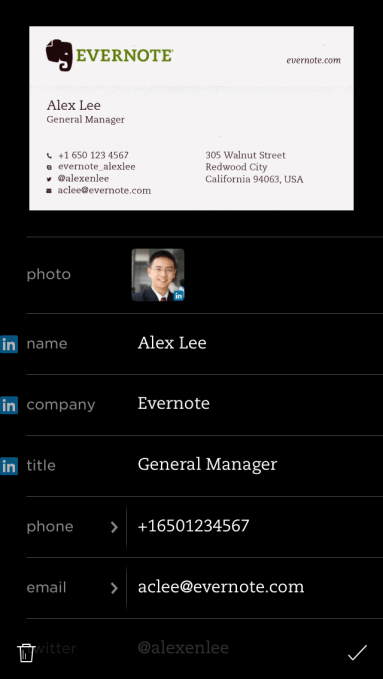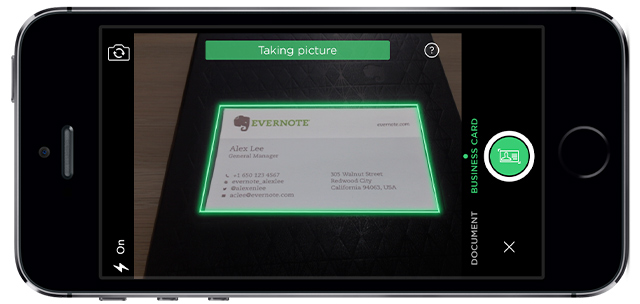An interesting development today for Evernote to push its stature with premium and business users, as well as some closure on an app that was nearly left for dead: LinkedIn and Evernote are today announcing a “deeper integration,” which will see LinkedIn shut down its CardMunch business scanning app on July 11, 2014; migrate users to Evernote; and then use the new connection to build out the two company’s respective businesses.
“We want to have a great user experience for business cards,” Evernote CEO Phil Libin explained to me in an interview. “We both think it’s a more valuable experience. The whole point of business cards is that they’re a lot more than a contact record. In Evernote they become a bookmark in your life, with context.”
It’s not clear how many active users are getting affected by this change, but Libin tells me that there is a significant volume of activity on CardMunch today: on average there are between 45,000 and 50,000 card scans per day using the app, “so there will be a whole lot of users.”
With the app shutting down, those CardMunch users will be given the option to upload business cards using Evernote’s new iOS apps. In turn, those scans will automatically call up LinkedIn profiles of users to add the now-digitized details to their Evernote contacts list.
The service initially will only be available on iOS, although Evernote tells me Android is coming soon.
While CardMunch had been a free service, on Evernote it will over time become premium. Existing CardMunch members will get free business card scanning on Evernote for two years, while Evernote users who are not on CardMunch can get one year free of business card scanning if they connect their LinkedIn and Evernote accounts. (Business card scanning is otherwise a paid, premium feature on Evernote.)
The backstory: When the business card scanning app CardMunch was acquired by LinkedIn back in 2011 for less than $3 million, we called it a like-minded and forward-thinking move. After all, business cards can be messy, and LinkedIn has long been holding an ambition to be the digital rolodex to the world — the place in the cloud where you keep track of your work contacts and connect with them. And the deal was sweet in that it made what was created as a paid service into something free.
But the service effectively died on the vine, with the original CardMunch app getting updated only once after that acquisition, in 2011, and even proving to be unreliable and broken for many. People complained, and we heard murmurs here and there that it would eventually be discontinued as LinkedIn focused on other ways of helping users manage their contacts.
At the same time, Evernote has been building up its business with an increasing number of premium services to entice users to move over from free to paid tiers. That’s had some, if not resounding success: Libin says that right now, out of Evernote’s 90 million active customers, some 4.5 million are taking paid services.
With LinkedIn now estimating that there are 300 million people in its network, this move is being made to make those paid services a little more useful, while also potentially helping Evernote tap into that larger customer base to bring up its own user numbers. At the same time, as Libin points out there are a number of countries that are targets for LinkedIn’s future growth, such as China, where Evernote will be key to picking up new users.
What’s interesting is that CardMunch was originally a cross between an analogue and digital solution — you scanned your card, but it was then verified by a human before being converted using Mechanical Turk. In fact, the human element of the service was one of the app’s selling points. Evernote, which has its own appreciation for the analogue aspects of life — “I like paper things, and I like making them better and relevant,” Libin told me yesterday — believes that even if that human involvement may have been necessary even two years ago, these days digitizing simply works better.
“OCR is our core competency,” Libin explained to me.
 Indeed, the new Evernote app is designed make it as pain-free as possible to digitize those cards: using the app, you point your handset at a business card on a table and shoot: Evernote identifies that it’s a card and automatically begins the process of finding relevant information on LinkedIn. Libin says that this is not an exclusive deal and there could be other data sources added in the future.
Indeed, the new Evernote app is designed make it as pain-free as possible to digitize those cards: using the app, you point your handset at a business card on a table and shoot: Evernote identifies that it’s a card and automatically begins the process of finding relevant information on LinkedIn. Libin says that this is not an exclusive deal and there could be other data sources added in the future.
It also builds on business card scanning features that are also available in Evernote for Mac and Evernote for Windows Desktop, when using the ScanSnap Evernote Edition Scanner.
The sweetener for users to take up the Evernote service is that it means they will be able to get more bang for their business card buck: while in the past the name simply became another contact in your phone, the Evernote version of the CardMunch experience will then be able to do all of the other things you do on Evernote, add notes, link up the contacts to meeting information and locations, and so on.
